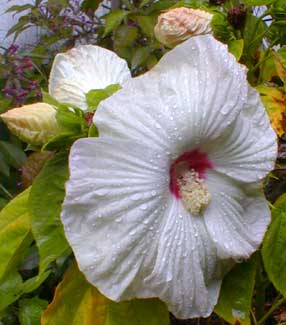
'Luna Blush White' Hardy Hibiscus
or Rose Mallow
"By the ruined mansion,
Fowls roaming
Among the hibiscus."
-Masaoki Shiki
(1867-1902)
(1867-1902)
Two to three & a half feet tall, clumping to two or three feet wide, Hibiscus moscheutos 'Luna Blush' has crepe papery hollyhock-like flowers, white occasionally with pastel pink edges & a bright red eye, easily six or seven inches across, occasionally called "dinner plate hibiscus" because of the flower size.
The white & the red varieties that make up the 'Luna Blush' series were developed by the Ball Horticultural Company. Semi-dwarf, they are slightly larger than the 'Disco Belle' series but only half the height of 'Southern Belle.'
It wants full sun & does not like drought, which is especially true for its first year in the ground. The leaves will quickly become homely if the soil entirely dries out, though it will usually if slowly slowly bounce back when irrigation is restored. The species is sometimes called "Swamp Mallow" because it can tolerate bogginess better than dryness, though moist well draining soil is best.
Our White 'Luna Blush' blooms for Summer & Autumn, usually lasting well into October though by then its leaves will already be turning yellow. The photo up top is from October.
Later in autumn it will need its dried out stems cut to within four or eight inches of the ground. In zones where the ground freezes in winter, the area over the root should be hilled or heavily mulched to a foot depth as is done for roses in frigid zones. On Puget Sound (Zone 8) it needs little or no special attention; a light mulching of leaves is plenty.
Rose Mallows are slow to reappear the following year; late May to early June should not be unexpected, so mark the location well lest you forget there is something planted there. It goes well with early spring bulbs which will dominate the space March & April, then be vanishing just as the Rose Mallow's sprouts appear.
When it does finally re-emerge, it takes off like a sun of a gun, becoming very bush-like with a woody appearance & large leaves. At midsummer (July or August) it begins flowering & even though each bloom lasts but a day or a day & a half each, it will be opening buds continuously until stopped in autumn whenever frosts begins. So while it can be frustrating waiting for it throughout spring, it makes up for its tardiness by lasting later in the year than do most other flowers.